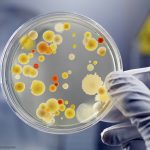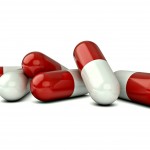Antibiotic resistant bactéria are becoming a serious threat to human health. The CDC estimates that 2,000,000 Americans are sickened with antibiotic resistant bacterial infections every year, and 23,000 die. For instance, antibiotic resistant Salmonella causes at least 6,000 illnesses every year in this country. Those numbers will most likely increase over the next few years. But a new study published in PLOS Biology has found that bacterial cells have a weakness in the wall surrounding them that could be used to destroy them. Gram negative bacteria, such as E. coli, have a cell envelope that is made up of an outer and inner membrane. The two membranes are separated by an area that is called the periplasm. That double membrane in the cell wall makes the bacteria more resistant to … [Read more...]
Scientists Find New Way to Fight Antibiotic Resistant Bacteria Through the Cell Wall
Kitchen Cutting Boards Harbor Antibiotic-Resistant Bacteria
A new study published in the Journal Infection Control and Hospital Epidemiology found that kitchen cutting boards can become contaminated with antibiotic-resistant bacteria from raw meat. Researchers at the University Hospital in Basel, Switzerland looked at 154 cutting boards before they were washed from the hospital and 44 from private homes after they were used to prepare pork, beef, veal, lamb, game, or fish. In addition, kitchen gloves worn during meat preparation were tested. The scientists discovered that 6.5% of the hospital cutting boards and 3.5% of the household cutting boards used to prepare poultry tested positive for "multidrug-resistant E. coli bacteria." None of the boards used for meat other than poultry dated positive. Fifty percent of the gloves were contaminated … [Read more...]
Consumer Reports: Most Chicken Harbors Pathogenic Bacteria
A new report to be published in the February 2014 issue of Consumer Reports finds that 97% of the chicken breasts they tested harbor pathogenic bacteria. Most deaths from food poisoning in the U.S. are attributed to poultry. So Americans must now assume that the raw chicken they bring into their houses is a hazard. Scientists analyzed more than 300 raw chicken breasts purchased across the U.S. More than half of those samples contained at least one bacterium that was resistant to three or more antibiotics. The Foster Farms outbreak this fall is just one example of the problem. Forty percent of those sickened in that outbreak were hospitalized, which is double the usual percentage, because the bacteria were antibiotic resistant. That makes salmonellosis much more difficult to treat. In … [Read more...]
Researchers Make Breakthrough on Antibiotic-Resistant Bacteria
Researchers at the University of Texas Health Science Center in Houston have made a breakthrough in understanding how some antibiotic-resistant bacteria develop that resistance. The research was published in mBio journal. Food safety advocates are concerned about the increase of antibiotic-resistant bacteria on the foods we buy, especially raw meat. Many factory-farmed animals are fed sub-therapeutic doses of antibiotics to prevent disease and help the animal gain weight. Studies have shown that the numbers of antibiotic-resistant bacteria are increasing, and many bacteria are becoming resistant to more than one antibiotic. Scientists observed how bacteria responded to fluorescent labeled daptomycin, one of the "last resort" antibiotics in use today. The cells divert the antibiotic … [Read more...]
Antibiotic Resistant Bacteria in Hudson River
A study published in the Journal of Water and Health has found that the Hudson River in New York contains antibiotic-resistant bacteria from untreated sewage water. The bacteria are resistant to tetracycline and ampicillin and were detected at all 10 sampling sites along the river. This study was the first to document widespread distribution of antibiotic-resistant bacteria in the Hudson River Estuary (HRE) and to demonstrate a link between the abundance of antibiotic-resistant bacteria and levels of sewage-associated bacteria in an estuary. The heaviest concentrations of these dangerous pathogens were in Yonkers and near La Guardia airport, where sewage water is being released into the river. About 27 billion gallons of waste water is released into the Hudson ever year. Hurricane Sandy … [Read more...]
Waxman and Slaughter Introduce Antibiotics Bill
Congresspersons Henry Waxman (D-CA) and Louise Slaughter (D-NY) have introduced a bill into Congress to better monitor antibiotic use in animals. The bill, H.R. 820, the Delivering Antimicrobial Transparency in Animals (DATA) Act, will provide information on the amount of and use of antibiotics given to animals raised for human consumption. Rep. Waxman said in a statement, "the widespread use of antibiotics in animals is a vital public health issue. We need to learn more about how these drugs are being used. With this information, scientists will be able to better pinpoint the relationship between the routine use of antibiotics in humans and the development of dangerous resistant bugs that can harm humans. This knowledge will inform scientists and Congress and start us down the path to … [Read more...]
Fix Antibiotics Food Finder Launched
Real Time Farms is launching a map to help consumers purchase meat and poultry from animals who have been raised without antibiotics. The Fix Antibiotics Food Finder lets you find retail locations, farms, restaurants, and farmers markets that carry antibiotic-free meat. Real Time Farms said that, "this campaign, as with so many things, comes down to people voting with their wallets because government is seen as moving too slowly." Consumers can add to the database if they have information that's not currently on the map. You can post photos from farms, food artisans, and farmers market, and add to and update vendor profiles. Retailers, farmers, and artisans can add to the guide too. In fact, restaurants can upload their menu and use the web site's tools to show where the food comes … [Read more...]










